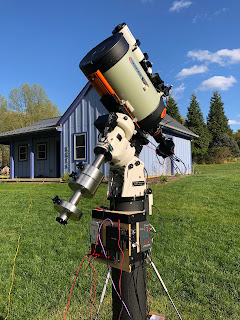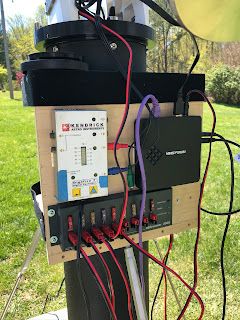The Pier stands 54" tall. Loading and unloading the OTA is a chore, but manageable provided I keep a close look at the step-stool I use. I just received a better step-stool from Lowes that should make this all a bit easier. You don't want to slip and fall carrying a $3500 optical tube that weighs in at about 35lbs.
The Astro-Physics GTOCP4 (with APCC software) is mounted on the south side of the pier. It controls the mount itself and all the specialty operations that the mount is capable of performing. It can operate standalone with either Ethernet or WiFi, so apps like SkySafari can control the scope directly.
On the north side is the Computer and Power Distribution assembly which contains the mini-computer, dew heater controller and the power distribution panel.
The MinisForum GN34 mini-PC (right side) controls all the equipment (cameras, filter wheel, guide scope camera, the mount, remote focuser, etc.) and has all the astro-software needed for astrophotography (Stellarium: planetarium software used to select and command the scope to target a specific object; SGP Pro: the image capture suite which is the main application that controls all the equipment; and a host of other apps.) It has an Intel Celeron J3455 processor, Intel HD graphics 500, 6GB LPDDR3 memory, 64GB eMMC storage, IEEE 802.11ac Dual Band WiFi, Bluetooth and Gigabit Ethernet. Features three USB3.0 ports, SD card slot and both HDMI and VGA ports. This is connected to a gigabit switch in my barn via a 100' network cable. The GN34 comes with Windows 10 Pro and so I control it via a remote desktop connection from any of my computers or mobile devices.
All the 12v power for the system (except for the AP1100 which has a dedicated 12v PS) is distributed via a West Mountain Radio RIGrunner 4008 power distribution panel from Powerwerx. Power is obtained from two Pyramid 12v power supplies, one for the mount and one for all the other equipment. The power cables on all my devices have been modified to use Powerpole connectors which go right to the RIGRunner. No more lost power due from the cheap car cigarette lighter plugs!
The Dew heaters are controlled by a Kendrick DigiFire 7 controller.
For expansion purposes (like when I run my QHY10 Camera) there is a 7-port powered USB hub mounted to the side of the power assembly. The MicroTouch focuser controller sides along the hub.
Both the GTOCP4 unit and the Computer and Power Distribution assembly can be easily removed and brought inside to protect them while the mount itself remains outside covered in a Telegizmos 365 Series Cover.
On April 22 the first EdgeHD image was taken with the new setup. This is an elliptical galaxy in the constellation Coma Berenices. Taken with the ASI1600mm Pro, this LRGB image was just over 1.9 hours of total integration time. To the left is NGC4394, a SBb barred spiral galaxy.
I expect to be taking lots of new images of dim, distant objects now that I have a mount up to the task. All I need now are clear skies :)



















